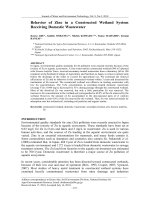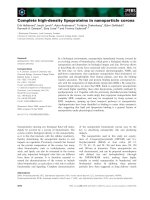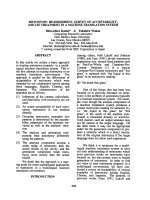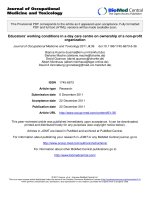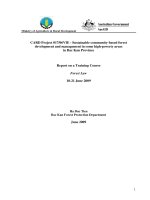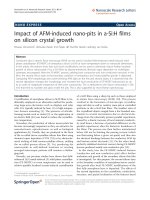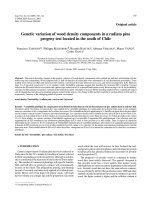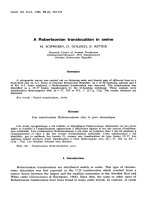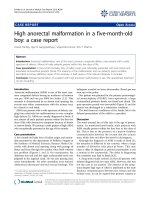Effects of high density stocking in a recirculating aquaculture system on gillmorphology of hybrid striped bass (moronesaxatilis x m chrysops)
Bạn đang xem bản rút gọn của tài liệu. Xem và tải ngay bản đầy đủ của tài liệu tại đây (9.9 MB, 25 trang )
Effects of High-density Stocking in a
Recirculating Aquaculture System on Gill
Morphology of Hybrid Striped Bass (Morone
saxatilis x M. chrysops)
BJ. Smith, S.A. Smith, and CJ. Pfeiffer
Aquatic Medicine Laboratory
Virginia-Maryland Regional College of Veterinary Medicine
Department of Biomedical Sciences and Pathobiology
Duck Pond Drive, Blacksburg, VA 24061
ABSTRACT
The types and distribution of gill lesions observed in hybrid striped
bass (Morone saxatilis x M. chrysops) reared in a commercial-scale
recirculating aquaculture system are described. When placed in the
system as fingerlings and reared there for eight months at typical
stocking density, the gills of all examined fish presented a variety of
extensive, non-specific lesions typically resulting from poor water
quality. Lesions included epithelial cell hyperplasia, infiltration of the
interfilamental region by mixed inflammatory cells, hyperplasia of
mucous and lamellar epithelium, lamellar fusion and occasional
filamental fusion. Up to 76% of the gill sample surface of individual fish
was affected, with lesions being most severe in the distal filamental
regions. Fish transferred to and maintained at low stocking densities in
water of superior quality demonstrated that all lesions were fully
reversible by five weeks post-transfer. This study demonstrates that
culture of hybrid striped bass under intensive aquaculture management
induced pathological changes in the gills, and suggests that maintenance
of fish under improved water quality conditions will reduce gill lesions,
which could potentially increase the fishes' performance.
International Journal of Recirculating Aquaculture, vol. 1, no. 1 35
INTRODUCTION
Recirculation aquaculture systems have become increasingly
significant in the culture of numerous species of economically important
fish. Benefits offered by recirculation systems include conservation of
water and energy, decreased environmental pollution, and increased
flexibility in the choice of aquaculture site location (Lucchetti and Gray
1988; Liao and Mayo 1974). Hybrid striped bass (Morone saxatilis x M.
chrysops) are among an increasing number of species being successfully
raised in intensive recirculation systems. In the interest of maximizing
economic return, fish are commonly stocked at the highest population
density possible without overtly affecting the fishes' health or growth.
Unfortunately, high-density stocking practices exacerbate the inherent
tendency of water in recirculation systems to carry high levels of
contaminants such as particulates, metabolic wastes, parasites, and
bacteria (Allen and Kinney 1981; Spotte 1979). The gills, being
continuously and unavoidably in direct contact with these substances,
respond with various structural and functional changes that can
compromise respiratory, excretory, and osmoregulatory efficiency.
(Roberts 1989; Ferguson 1989). By affecting gill function, even
moderate changes in gill structure can affect the fishes' behavior,
appetite, and homeostasis, and thus also have the potential to adversely
affect growth and development.
The effects on gill morphology of rearing fish in recirculating systems
under present management practices have not been closely scrutinized.
However, conditions documented as significant stress factors, including
poor water quality, overcrowding, and excessive handling, have long
been known to occur in commercial recirculation systems (Amend
1970). Water quality parameters experienced in such systems may induce
types and degrees of pathological change in the gills that have the
potential to decrease fish performance and thereby decrease eco'nomic
return. This study was undertaken to examine the hypothesis that highdensity stocking of hybrid striped bass in recirculation systems as is
commonly practiced in commercial aquaculture operations would induce
significant gill pathology. Further, this study also aimed to characterize
the nature of any gill lesions that developed, as well as to determine
whether the resulting pathological changes were reversible.
36 International Journal of Recirculating Aquaculture, vol. l, no. 1
METHODS
Fingerling hybrid striped bass (7-10 cm in length) were obtained from
a commercial source where they had been reared in ponds. Six fish were
arbitrarily selected as an incoming group to examine the microscopic
anatomy of the gills at the outset of the study and determine whether
significant underlying gill pathology was present at the outset of the
study. These six fish were immediately anesthetized with tricane
methanesulfonate (MS-222, Sigma Chemical Co., St. Louis, MO, USA)
and killed by cervical dislocation. Tissue samples consisting of the gill
arch and associated holobranchs were obtained from the second gill arch
of each fish and placed in fixative (5% glutaraldehyde, 4% formaldehyde, and 2.75% picric acid in 0.05% cacodylate buffer, pH= 7.4).
The remaining fish were divided into two groups and placed in
recirculating systems where they were reared for eight months. One
group (control; n =21) was maintained at low population density (:s; 2.5
kg/m3) in 1,893 liter (500 gallon) circular tanks with a sand filter for
mechanical.filtration and a trickle filter with Bio-Pac 150 (NSW Corp.,
Roanoke, VA, USA) as the biological filter. Water quality in this tank
was main-tained within parameters defined as superior (i.e., they were
better than those currently considered acceptable by the production
industry: temperature 26 ± 1°C; pH 7.2-7.4; TAN< 0.1 mg/L; N0 2 <
0.01 mg/L; N03 < 50 mg/mL; DO 8-10 mg/L; alkalinity> 150 mg/L;
hardness> 200 mg/L) throughout the eight-month period. The second
group (experimental) (5000 fingerlings with fish graded and removed at
appropriate.intervals) was reared for the eight-month cycle in a 11,356
liter (3000 gallon) recirculation system with a sump discharge for
mechanical filtration and a rotating biological contactor for biological
filtration. Fish in both groups were fed a commercial diet (Floating Fish
Nuggets, 40% protein, Zeigler Bros., Gamers, PA, USA) twice a day at
5-6% body weight. At the end of the production cycle, fish density in the
control group neared 2.5 kg/m3, while that in the experimental group had
reached 130 kg/m3 of water. Water quality parameters in both systems
were determined weekly. When water quality deteriorated beyond
acceptable industry limits in the experimental group, appropriate water
changes were performed.
At the end of the 8-month period, representatives from both the control
and the experimental groups (six and nine fish, respectively) were
International Journal of Recirculating Aquaculture, vol. l, no. 1 37
arbitrarily removed and gill samples obtained as previously described.
The remaining 15 control fish were maintained in their original system,
in which the stocking density remained low. From the experimental
group, 15 fish were arbitrarily selected to investigate the reversibility of
any lesions that had developed. These fish were placed in recirculation
systems like that in which the control fish were held, and in which the
population density was kept low (less than ~ 2.5 kg/m3) and the water
was maintained at superior quality. Gill samples were obtained weekly as
previously described from three arbitrarily-selected fish in each of the
groups for a total of five weeks. Gill tissues from the experimental group
were compared to those of control fish as well as to published normal
anatomy for striped bass and their hybrids (Groman 1982; Pfeiffer et al.
2000).
Tissues were prepared for light microscopy (LM) by routine
histological technique (Luna 1968; Hinton 1990), embedded in EM 400
embedding medium (Surgipath Medical Industries, Richmond, IL, USA),
and sectioned at 6 µm. Separate slides from each sample were stained
with hematoxylin/eosin (H&E) and the periodic acid-Schiff (PAS)
reaction. For LM evaluation, samples were standardized to include a
length of gill arch that included 10 to 20 gill filaments presenting
.
- ·- "\ ~-
~
·_
Figure 1. Schematic representation
ofsites on the gill at which mucous
cells were enumerated.
L = lamellar, F =filamental, and
I = interfilamental sites.
38 International Journal of Recirculating Aquaculture, vol.
l, no. 1
lamellae along both sides of the length of the filament. For each sample,
ten filaments were evaluated for morphological structure and pathologic
change. Pathologic changes were evaluated using H&E-stained slides,
characterized descriptively, and expressed as a percentage of filament
length involved. To calculate the percentage of affected gill surface, the
length of filament showing structural anomalies was divided by the total
length of the filament. Slides stained with PAS were evaluated to detail
alterations in number and location of mucous cells. Mucous cells were
enumerated in the interfilamental regions at the base of 10 filaments, in
the interlamellar spaces between the bases of the lamellae, and on the
surfaces of the lamellae (Figure 1).
For transmission electron microscopy (TEM), tissue was fixed
immediately at 4°C, washed in buffer, postfixed in 1% osmium tetroxide
in 0.1 M cacodylate, washed in buffer again, dehydrated through a graded
series (15% to 100%) of ethanol, transferred to propylene oxide, and
embedded in Polybed 812 (Polysciences Inc., Warrington, PA, USA). Thin
sections were doubly stained in lead citrate and uranyl acetate, and viewed
in a JEOUOO CX-11 transmission electron microscope (JEOL, Peabody,
MA, USA) operating at 80 kv.
For statistical evaluation, the percentage abnormal gill surface and
counts of the number of mucous cells in the interfilamental regions at the
bases of the lamellae, in the interlamellar spaces, and on the surfaces of
the lamellae were measured on 10 lamellae for each fish. For each of the
four response variables, one measurement per fish was calculated by
averaging the values from the 10 lamellae. Separate one-way ANOVA
models were used to test whether sampling time had an effect on the
percent abnormal gill surface and mucous cell counts from the three
areas evaluated. ANOVA assumptions were evaluated by looking at
normal probability plots of the residuals and plots of residuals against the
predicted values. The normality of the residuals and equality of variances
were substantially improved by a natural log transformation of the data.
Sheffe's multiple comparisons procedure was used to make pairwise
comparisons between sampling times. For all tests, a p-value of <0.05
was considered significant.
International Journal of Recirculating Aquaculture, vol. l, no. 1 39
RESULTS
Incoming Fish
The histologic structure of the gills in the incoming group of fish was
considered normal as compared with published reports of normal
anatomy (Groman 1982; Pfeiffer et al. 2000).
Control Fish
Water Quality -- Water quality parameters remained within superior
limits during the entire rearing period (data not shown).
Clinical Appearance of Control Fish -- Control fish appeared clinically
normal on daily visual inspection throughout the study. The fish
displayed normal swimming, feeding, social, and resting behavior, and
grew at a rate typical of hybrid striped bass in commercial production.
Gill Histology -- The histologic structure of at least 94% of the gill
surface in control samples was normal (Table 1, Figure 2) as was
comparable to normal anatomy (Groman 1982; Pfeiffer et al. 2000).
Filaments (Figure 3) were regularly arranged along the gill arch, with
lamellae projecting freely and uniformly along the entire length of the
filament. Interfilamental cells at the base of the filaments were present in
appropriate types and numbers, consisting of a thin layer of mainly
Table 1. Percent Abnormal Gill Area in Control, High-Density, and Recovering Fish
Control
High-density
Week I Recovery
Week 2 Recovery
Week 3 Recovery
Week 4 Recovery
Week 5 Recovery
Percent Abnormal Gill Area
Number of Fish
2
4
5
1
3
6
5.9
61.5
45.9
25.9
23.3
11.0
5.7
5.1
71.5
48.9
27.4
23.8
10.9
4.8
9 Overall Mean
7
8
5.4 5.1
5.7 5.6
5.5
64.0 67.5 76.l 73.7 72.8 69.9 71.7
69.9
47.0
47.3
25.6
26.3
23.3
23.5
10.2
10.5
5.3
5.3
For individual fish identified by number; each percentage reported is the mean for 10
filaments counted perfish. For the overall mean, the number reported is the arithmetic
mean ofall values within that group. For the control group, n = 6; for the high-density
group, n 9; for the recovering fish, n 3. Dashes indicate a zero value in that
category.
=
=
40 International Journal of Recirculating Aquaculture, vol. 1, no. 1
undifferentiated cells, together with small numbers of chloride cells and
isolated migrating leukocytes and eosinophilic granulocytes. Normal
lamellar structure was typified by pillar cells separating capillary spaces,
with the external lamellar surface covered by squamous epithelial cells.
Occasional mucous cells were present in the interfilamental spaces.
Greater numbers of mucous cells were found along the filaments, but were
rare or absent along the lamellae (Table 2). Ultrastructurally, control gills
(Figure 4) were typified by normal cellular structure of the principal cell
types, including the surface epithelial cells of the secondary lamellae,
pillar cells, and vascular endothelial cells.
Histological abnormalities were rarely observed in the control gills, and
were restricted to small, localized sites of minor proliferation of
interlamellar epithelial cells at the base of the lamellae, or, more rarely, in
the interlamellar space.
Experimental (High-Density Stocked) Fish
Water Quality -- Experimental group water quality parameters
generally remained within limits considered acceptable by production
industry standards, though departures from acceptable limits
occasionally occurred (Table 3). Near the end of the production cycle,
despite the water quality parameters being generally acceptable, a higher
concentration of suspended feed particles and organic debris often
caused the water to become visibly turbid and brownish.
Clinical Appearance -- Throughout the study, the experimental fish
appeared clinically normal on daily visual inspection. As with controls,
the fish displayed normal swimming, feeding, social, and resting
behavior, and appeared by visual inspection to grow at a rate typical of
healthy hybrid striped bass.
Gill Histology ofExperimental (High-Density Stocked) Fish -- Lesions
of various types involving the majority of the gill surface (Table 1,
Figure 2) were manifested in all market-aged fish at all levels along the
length of the filament, though the full length of individual filaments was
never involved. Twisting of filaments near lesions were generally most
severe at the bases of and along the distal half of the filaments (Figure 5).
The mid-regions of the filaments were affected to a lesser degree or not
at all. Areas of severely affected tissue were often flanked by areas with
less pathologic change.
42 International Journal of Recirculating Aquaculture, vol. l, no. 1
Table 3. Water Quality Parameters from Tanks Holding Hybrid Striped Bass at High
Density
Week
1
2
3
4
5
6
7
8
9
10
11
12
13
14
15
16
17
18
19
20
21
22
23
24
25
26
27
28
29
30
31
32
33
Temp.
pH
(22-28'C)
(7.2-8.6)
25.9
25.5
26.0
27.5
25.5
26.7
27.4
27.8
27.5
26.5
28.0
28.2
27.6
26.9
27.4
27.0
27.0
25.9
26.9
25.7
24.6
24.3
24.1
25.6
43.7
22.7
24.4
24.4
24.4
24.3
24.6
24.1
24.1
8.3
7.8
7.7
7.5
7.7
7.8
7.9
7.8
7.5
7.8
7.6
7.6
7.6
7.3
7.3
7.9
7.9
7.4
7.3
7.4
7.7
7.6
7.8
7.7
8.0
8.0
7.6
7.6
7.6
7.4
7.3
7.3
7.3
TAN
N02
N03
DO
ALK
(<2.0 mg/L) (<1.0 mg/L) (<150 mg/L)(>5.0 mg/L)(>125 mg/L
CaC03)
0.25
0.31
0.47
0.61
0.70
0.83
0.72
0.85
1.04
1.12
1.21
1.28
1.30
1.26
1.07
0.75
0.95
0.87
0.75
0.65
0.80
0.88
0.83
1.18
1.13
1.65
1.56
1.04
1.18
1.22
1.51
1.47
1.47
0.39
0.23
0.28
0.27
0.36
0.21
0.15
0.10
0.19
0.28
0.54
0.19
0.52
0.12
0.34
0.38
0.49
0.79
0.15
0.16
0.35
0.36
0.45
0.24
0.25
0.34
0.56
0.61
0.16
0.54
0.36
1.53
1.47
5
11
15
22
30
33
26
31
77
83
40
83
91
115
169
141
258
227
119
152
115
116
43
111
30
98
116
81
18
109
64
175
97
10.3
12.0
10.4
12.5
12.8
11.2
11.0
11.3
11.0
9.4
8.7
11.5
12.8
11.9
12.2
14.1
15.5
14.4
13.0
14.3
15.4
13.3
14.7
13.2
13.5
14.3
13.0
13.4
14.7
14.4
15.3
12.6
14.8
160
128
149
172
NA
236
274
142
115
105
110
115
124
117
109
117
216
161
150
215
179
230
252
143
201
203
225
171
169
139
130
94
125
Hardness
{>200 mg/L
CaC03)
325
180
312
368
NA
456
500
450
400
492
NA
NA
658
578
604
630
471
545
489
524
382
371
329
280
386
428
379
450
338
401
340
419
350
Numbers in parentheses under each parameter indicate desired limits for intensivelyraised hybrid striped bass (modified for recirculation systems from Harrell et al.
1990). TAN indicates total ammonia nitrogen, NA indicates not available.
. International Journal of Recirculating Aquaculture, vol. l, no. 1 43
Lesions of the basal interfilamental region were typified by a thickening
of the interfilamental cellular layers, caused by proliferation of epithelial
cells. and marked infiltration of the interfilamental region by mixed
inflammatory cells. The thickening often extended to a level that engulfed
some of the most proximal lamellae (Figure 6). The deepest layer of this
thickened region contained primarily lymphocytes and macrophages, which
extended from the basal region into and throughout the superficial layers as
well. In the intermediate layers, these cells were joined by inflammatory
cells possessing large eosinophilic granules. The superficial-most layer
demonstrated increased numbers of mucous cells.
Lesions of the distal filaments were typified by proliferation of both
epithelial and mucous cells on the lamellae (Figures 7-9). The number of
mucous cells was significantly increased along both the filament and on
the lamellae (Table 2; Figures 8,9). Mucous and other epithelial cellular
proliferation and accumulation were sufficient to produce prominent,
widespread lamellar fusion (Figures 8,9), which involved as much as a
mean of 40% of the surface of affected filaments. In some areas, the
fusion was so severe as to require careful examination of lamellar
capillaries to distinguish adjacent lamellae (Figure 8).
Ultrastructurally, the gills of high-density stocked fish demonstrated a
variety of pathologic changes. The lamellae demonstrated disruption of
the pillar cells which resulted in the separation from their flanges
supporting the central blood spaces (Figures 10, 11 ). Further, marked
enlargement of the subepithelial lymphatic spaces was evident, and the
presence of granulocytes within these spaces was greatly increased
(Figures 10,11). Membranous inclusions of obscure origin were
common, both within the central blood spaces and the subepithelial
lymphatic spaces. Small, electron-dense cytoplasmic granules became
numerous within apices of the outer epithelial cells lining the secondary
lamellae (Figure 10), though they were not prevalent in the control
epithelia (Figure 4 ). Small cytoplasmic vacuoles were also noted in the
outer epithelial cells covering the secondary lamellae.
Recovering Fish Transferred to Water of Superior Quality
Figure 2 and Table 1 show the percentage of gill surface with
histopathological abnormalities in recovering fish. Evaluation of mucous
cell numbers in these same fish is presented in Table 2.
44 International Journal of Recirculating Aquaculture, vol. 1, no. 1
2A. Abnonnal Giii Surface
2C. Mucous Cells on Giii Fiiament
~
~ 4.5
~
4
i3
3.5
'ii
gE
3
~ 2.S
c..
2
u
: 1.5
Qi
"
1
~ 0.5
5
0
w..k
20. Mucous Cells on Lamellae
28. Mucous Cells in lnterfilamental Space
..
'il
..6
v
4.5
2.S
4·
!!J
2
~
~
~ 2.5
u
~ 1.5
::!:
.,
1l
~
~
.Q
E
:i
E
1
5
1.5
~
Qi
~"
3.S
~ 0.5
~
.5
0.5
w..k
0
·0.5
Wtok
Figure 2. Percent abnormal gill surface (2A), and numbers ofmucous cells in the
interfilamental space (2B), on thefilament(2C), and on the lamellae (2D) in control
(n =6), high-density (n = 9), and recovering (n = 3 in each group)fish.
Values shown are the group means ofthe natural log (Ln) transformed data. Error bars
are 2x the SE ofthe mean.
* Indicates values significantly different from control,
t Indicates significantly different from the immediately preceding measurement,
p< 0.05.
International Journal of Recirculating Aquaculture, vol. l, no. 1
45
One week post-transfer, gill tissue occasionally demonstrated
resolving mild lesions of terminal vessel dilation (telangiectasis).
Proliferative lesions and lamellar fusion in the distal region of the
filaments were reduced to a mean of 45.9% of the gill surface (Table 1,
Figure 2). The severity of these lesions was also greatly reduced as
reflected in decreases in depth of proliferated cells in the interfilamental
spaces and in the length of the filaments exhibiting lamellar fusion, as
well as in absence of fusion of adjacent gill filaments. Mucous cells,
though still present in elevated numbers (Table 3, Figure 2), appeared to
be less active than in samples from high-density stocked fish, being
smaller in size and presumably containing less mucus.
After two weeks of maintenance in superior quality water, areas of
proliferation were further significantly decreased to a mean of
approximately 25.9% of the gill surface (Table 1, Figure 2). The number
of mucous cells on the lamellae were reduced to a level similar to
controls, and remained so for the duration of the study (Table 3, Figure
2). Proliferation of mucous and epithelial cells as well as infiltration of
inflammatory cells persisted in the regions between the basal
interfilamental region, but were reduced from the one week post-transfer
fish. The number of mucous cells in the interlamellar regions and on the
filaments was decreased (Table 3, Figure 2), and the thickness of
proliferated cells in the interlamellar spaces as well as along the lamellae
was also reduced.
The types of lesions observed in the three week post-transfer fish were
similar in distribution to the two week fish, but lesion severity continued
to decrease. Numbers of mucous cells in the interfilamental regions and
on the filaments approached control levels (Table 3, Figure 2). The
thickness of proliferated cells in the interlamellar and interfilamental
regions was further reduced, as was the proximal-to-distal length of
involved lamellar regions. Lamellar fusion was no longer evident in any
region of the gill.
By five weeks post-transfer, nearly all gill filament samples were
similar in appearance to control tissues. Departures from normal
histological structure were reduced to a mean of less than 10% of the gill
surface (Table 1, Figure 2), and were characterized by only occasional
areas of minor proliferation of epithelial cells in the interlamellar areas.
Numbers of mucous cells were comparable to control levels in all
locations.
46 International Journal of Recirculating Aquaculture, vol. 1, no. 1
Fig,3
Fig,.4
Figures3-5
Figure 3. Light micrograph ofnormal gill
filament. Lamellae (L) project freely from each
side ofthe filament ( F) with abundant water
space between them. Squamous epithelial cells
cover the surface ofthe lamellae, and the bloodwater barrier is appropriately thin. Hematoxylin
and eosin, x = 300.
Figure 4. Transmission electron micrograph ofnormal morphology ofa secondary gill
lamella showing pillar cell (P) with large, centrally-located nucleus (N) and a distinct
basal lamina (BL) surrounding both the pillar cells and the central blood spaces (S).
Portions oferythrocytes (E) are present within the respiratory channels. Outer (OC)
and inner (IC) epithelial cells can be observed covering the lamellae, as well as
subepithelial pymphatic spaces (LS). x 19,440.
=
Figure 5. Light micrograph showing distribution oflesions along the length ofgill
filaments ofhigh-density stocked fish. The basal interfilamental regions demonstrate
some thickening ofepithelial cell layers (arrows). Lamellar lesions are most
prominent alone the distal region ofthe filaments, with lamellae along the more
proximal part ofthe filament far less affected. Hematoxylin and eosin, x = 15.
International Journal of Recirculating Aquaculture, vol. 1, no. 1
47
,,
..
'·
~
Figures 6-8.
Figure 6. Light micrograph demonstrating thickening of epithelial cells
in the basal inteifilamental region in
a high-density stocked fish. The
layers ofproliferated epithelial cells
are infiltrated by mixed inflammatory
cells, and mucous cells are numerous
in the most supeificial layer
(arrows). Hematoxylin and eosin,
x = 75.
Figure 7. Light micrograph demonstrating mild epithelial cell proliferation in high-density stocked fish.
Proliferated layers of epithelial cells
in the interlamellar spaces have extended only slightly distally along the
length of the lamellae. Though the
proliferation of epithelial cells is only
mild, mucous cells (arrows) are
greatly increased. Periodic acidSchiff, x = 240.
Figure 8. Light micrograph ofa segment ofa filament from a high-density stocked fish
showing moderate (MP) and severe (SP) epithelial cell proliferation. In the severe
region, proliferation has proceeded to the point of lamellar f usion. Elevated
numbers ofmucous cells (arrows) are clearly demonstrated. Periodic acid-Schiff,
x = 150.
48 International Journal of Recirculating Aquaculture, vol. l , no. 1
Figure 9. Light micrograph ofa region of
severe lamellar fusion. The entire
interlamellar space (IS) is filled with
proliferated and/or sloughed epithelial
cells, effectively removing this area of
the gill from respiratory function.
Periodic acid-Schiff, x = 300.
Figure 10. Transmission electron micrograph
ofsecondary gill lamella of high-density
stocked fish showing numerous,
commonly-observed cytopathologic
changes including enlargement and
coalescence ofthe subepithelial
lymphatic spaces (L), accumulation of
granulocytes (G) within those spaces,
disruption ofpillar cells (P),
vacuolization ofepithelial cell cytoplasm
(arrow), and presence ofmembranous
inclusions (M) in the vascular and
lymphatic spaces. x = 7540.
International Journal of Recirculating Aquaculture, vol. 1, no. 1 49
Figure 11. Transmission electron
micrograph ofsecondary gill
lamella of high-density stocked
fish showing alterations similar
to those demonstrated in Figure
10, but at a more advanced
stage ofpathology. Greater
thickening ofgill lamella, more
pronounced disruption ofpillar
cells (P), more numerous
membranous inclusions (M) in
both the vascular and lymphatic
spaces, and enhanced accumulation ofsmall, dense granules
in the cytoplasm ofthe outer
epithelial cells (arrow) are
observed.
x = 7540.
Fig.11
DISCUSSION
The minor areas of proliferative tissue present in the control fish were
considered unremarkable. Such variation is typical of many species of
wild and cultured fish inhabiting clean water (Ferguson 1989; Solangi
and Overstreet 1982; Haensly et al. 1982; Ribelin and Migaki 1975), and
hence is representative of the range of variation typically present in
normal healthy fish. Though such foci do represent departures from
normal, when small and few they are not considered significantly
pathological to the gill as a functioning organ (Haensly et al. 1982). The
similar foci observed in the five week post-transfer fish were also
considered to be within normal limits.
The ultrastructural data clearly illustrate not only some specific
cytopathological changes in the secondary gill lamellae resulting from
over-crowding of the fish, but also the structural basis for impairment of
respiratory gaseous transport as well as excretory and osmoregulatory
50 International Journal of Recirculating Aquaculture, vol. l, no. 1
functions. In normal fish, the water-blood barrier consists of pillar cells
flanges, a basal lamina, and thin layers of epithelial cell cytoplasm. In
fish showing pathological changes, this transport barrier was
significantly increased by either fusion of some of the secondary gill
lamellae, or by a several-fold increase in the portion of the barrier
consisting of the two-cell thick epithelial cell layer, as well as by mucus
accumulation and enlargement/extension of the subepithelial lymphatic
spaces. The origin of the membranous inclusions noted in the vascular
and subepithelial lymphatic spaces remains obscure, but probably
represent fragments of cellular membrane products (Hinton, personal
communication). Nonetheless, their common occurrence in the crowded
fish and absence in the uncrowded fish suggests that these bodies
develop in response to some factor(s) experienced by the fish under
high-density stocking. Such factors could involve stress on the fish,
water quality, some other unidentified factor, or a combination of
multiple factors. The ultrastructural changes observed in this study of
hybrid striped bass resembled the acute inflammatory effects in gills
reported in rainbow trout exposed to a specific water contaminant, zinc
sulfate (Skidmore and Tovell 1972), which resulted in respiratory
collapse and death.
Development of gill lesions was anticipated in fish reared at high
population density in the intensive recirculating system. Though water
quality parameters generally remained within limits considered
acceptable, levels of potentially irritating substances such as suspended
particulates or metabolic wastes were nonetheless elevated as compared
to what would be encountered in open, unpolluted waters. Continuous
exposure to these physical and chemical irritants likely contributed to the
development of the changes observed.
The lesions that developed in these gills were non-specific in nature
(Roberts 1989; Mallat 1985; Ribelin and Migaki 1975), and were similar
to what has been described in studies involving exposure to diverse
substances such as crude oil, ammonia, molluscicides, herbicides, and
pesticides (Cruz et al. 1988; Soderberg 1985; Haensly et al. 1982;
Solangi and Overstreet 1982; Eller 1969; Eller 1971). Further, similar
effects have been reported in salmonids reared using re-used water or in
recirculation systems (Macconnell 1989; Morrison and Piper 1988). The
relatively few cell types present in the gill tissue together with the simple
structural arrangement of those components result in only a limited range
International Journal of Recirculating Aquaculture, vol. 1, no. 1 51
of possible histopathological responses to any of a wide variety of insults
(Roberts 1989). In particular, epithelial hyperplasia with or without
fusion of adjacent lamellae, mucous cell hyperplasia, and inflammatory
cell infiltration are characteristic of a chronic stress response (Roberts
1989; Ferguson 1989; Mallat 1985). This contrasts with certain
conditions that induce specific changes, such as hyperplastic gill
response in fish exposed to ammonia (Smart 1976; Larmoyeux and Piper
1973; Burrows 1964), increased chloride cells following exposure to acid
water (Karlsson-Norrgren et al.1986; Leino and McCormick 1984) or
nitrite (Gaino et al. 1984), and chloride cell degeneration and necrosis in
nitrite and cadmium toxicity (Ferguson 1989). Proliferation of epithelial
cells and particularly of mucous cells can contribute to the lamellar
fusion that was prominent in the market-aged fish (Ferguson 1989;
Roberts,1989).
Gill lesions from a number of etiologies may be distributed diffusely
along the gill arch (Ferguson 1989; Mallat 1985), while other etiologies
such as exposure to crude oil and other factors (Ferguson 1989; Solangi
and Overstreet 1982) are characterized by a distal-filamental localization
of lesions. Alterations observed in this study were more similar to the
latter, being distributed mainly along the distal third to half of the arch.
Severe histopathological alteration such as lamellar fusion effectively
reduces the surface area of gills available for respiratory and other
functions. Decreased oxygen intake caused by severe proliferative
lesions and resulting impairment of respiratory exchange can be the
primary cause of death in certain conditions such as zinc toxicity
(Hughes 1972; Skidmore 1972,1970; Burton et al. 1972). However,
when such lesions are only moderate and/or when not diffusely spread
among the filaments, exchange across less-affected regions of the gills
may adequately compensate for the damaged regions (Roberts 1989).
Modifications in cardiovascular function have also been postulated to
contribute to such compensation (Goldes et al. 1988). This is particularly
true when fish are not achieving or sustaining high levels of physical
activity (similar to the fish in this study and other intensive aquaculture
systems), since in such instances the distal regions of the filament are not
fully perfused (Ferguson 1989). Pantothenic acid deficiency (classical
"nutritional gill disease") of rainbow trout presents a similar situation in
which fish having severe lamellar fusion along the distal filamental
region but little involvement of the more proximal filamental region
52 International Journal of Recirculating Aquaculture, vol. 1, no. 1
show little clinical evidence of distress when maintained under inactive
conditions (Karges and Woodward 1984; Poston and Page 1982).
Dilation of small or terminal gill vessels (telangiectasis) has been
described in association with chemical exposure, parasitic infestation, or
metabolic wastes (Roberts 1989; Haensly et al. 1982; Redner and
Stickney 1979; Smart 1976). This lesion also commonly develops in
farmed fish following their physical handling associated with size
grading and/or pond transfer (Roberts 1989). In the present work,
resolving telangiectasis was observed only in the group sampled shortly
after transference between tanks, rather than in any of the fish in groups
maintained in the recirculation system for extended periods of time
before sampling. This suggests that the telangiectasis developed related
to the handling of the fish during transfer, rather than to water conditions
in the recirculation system.
The alacrity with which mucous cell number on the gill lamellae is
striking. The numbers of mucous cells decreased precipitously during the
first week, decreasing from an overall mean of 42. 7 cells in the highdensity fish to 1.3 cells at 1 week post-transfer (Table 2, Figure 2).
Lamellar mucous cell numbers then reached normal levels during the
second week. In contrast, the number of mucous cells in the
interfilamental spaces and on the gill filament did not reach normal
levels until the third and fourth weeks, respectively. Further, the decrease
in mucous cells in these other areas was more gradual, rather than being
abrupt as on the lamellar surface. That the lamellar surface should clear
of abnormally high numbers of mucous cells both rapidly and before
other areas, may present an adaptive response in that the swift return of
this area, which is the main respiratory surface, to normal structure
would promote an expedient return to a normally-functioning state of
this strategic portion of the gill.
The rapid resolution of the proliferative lesions was likely related to
the extensive epithelial tissue component of the gills, the nature of the
lesions, and the placement of the fish in clean water (i.e., removal from
inciting conditions caused by less than superior water quality in the
recirculation system). Epithelial tissues inherently possess rapid
regenerative capacity, and organs with large amounts of epithelium are
often capable of swift recovery from minor to moderate damage once the
insult is removed. In keeping with such characteristics, gills are wellInternational Journal of Recirculating Aquaculture, vol. I, no. 1 53
characterized as able to recover rapidly from sub-lethal injury (Ferguson
1989; Goldes 1988; Fukuda 1983). Degenerative lesions resolve more
quickly than necrotic lesions, since generation of new cells is not
necessary. In this regard, the preservation of the basement membrane
observed in this study likely facilitated rapid recovery. Placing the fish in
superior quality water eliminated stimuli for continued excessive
epithelial and mucous cell proliferation, as well as for excessive mucus
production by proliferated cells. The flushing action of clean water is
also documented as contributing to the removal of accumulated mucus
and cells (Roberts 1989).
Though development of gill pathology in the experimental group was
expected, the extent of the gill surface involvement was not. With
significant structural alterations distributed over more than half of the
gill surface, the absence of overt effects on the behavior and growth of
the fish is noteworthy. Such apparent well-being of the fish could be
misleading. Despite acceptable growth, the deteriorated condition of the
gills could contribute to increased susceptibility of the fish to stressors
like bacterial, viral, fungal, or parasitic infections or other forms of
challenge. Further, resulting morbidity could be more severe than in fish
where the gills were in better condition. For instance, increased water
temperature and resulting decreased oxygen saturation could induce
mortality in fish with damaged gills that otherwise might survive
(Roberts 1989). Similarly, overcrowding of fish is known to be an
important predisposing factor in numerous diseases (Roberts 1989;
Ferguson 1989; Ribelin and Migaki 1975). Therefore, impairment of
normal respiratory, excretory, and osmoregulatory function resulting
from structural and functional compromise of the gill caused by such
conditions may be a major contributing factor in the susceptibility of fish
to other disease conditions, despite seemingly healthy condition and
adequate growth.
Despite the fact that fish raised at high population densities in
recirculation systems with less than superior quality water can survive
and grow at an economically-profitable rate, the results of this study
have important implications for the aquaculture industry. First, this study
demonstrates that fish raised under present aquaculture practices in these
systems develop extensive structural alterations along the majority of the
exchange area of the gill surface, the character of which could potentially
alter respiratory, excretory, and osmoregulatory functions. By affecting
54 International Journal of Recirculating Aquaculture, vol. 1, no.
l
such functions, growth performance and feed efficiency of the fish could
be negatively impacted, as has been previously shown in channel catfish
(Robinette, 1976; Soderberg et al. 1984). Therefore, production
performance of fish as commonly reared in intensive recirculation
systems, though considered acceptable, may not necessarily reach full
potential. The reversibility of the lesions suggest that fish in production
facilities could respond quickly to significant improvements in water
quality. Practical and economic considerations of most production
facilities preclude the maintenance of water conditions similar to those
used in the recovery phase of this study. Nonetheless, moderate
improvement of water conditions would likely decrease gill lesion
severity. Such improvement could improve respiratory, osmoregulatory,
and excretory functions of the gill, thereby potentially improving both
the performance of the fish and ultimately increase economic return.
Further, improving gill health prior to and after inducing significant
stress on the fish by stressors such as handling procedures could assist in
maintaining physical and physiological condition of the fish. Whether
increased return generated by such practices will exceed the cost and
logistics of implementation is yet to be determined, but invites
investigation.
ACKNOWLEDGEMENTS
The authors wish to thank Dr. George Libey for his assistance in the
project and review of the manuscript, Mr. Mark Kidd for maintenance of
fish in the commercial-scale recirculation system, Ms. Sandy Brown for
maintenance of fish in the recovery system, and Ms. Amelia Walton for
histological preparation.
International Journal of Recirculating Aquaculture, vol. 1, no. 1
55
REFERENCES
Allen, L.J., Kinney, E.C., (eds.), In: Proceedings of the Bio-engineering
Symposium for Fish Culture, American Fisheries Society. Fish
Culture Section 1981, Bethesda, Maryland.
Amend, D.F. Myxobacterial Infections of Salmonids: Prevention and
Treatment. Diseases of Fishes and Shellfishes. American Fisheries
Society Spec 1970, Publ 5, 258-265.
Burrows, R.E. Effects of Accumulated Excretory Products on Hatcheryreared Salmonids. Research Reports ofthe U. S. Fish and Wildlife
Service 1964, 66, 1-12.
Burton, D.J., J~nes, A.H., Cairns, J. Acute Zinc Toxicity to Rainbow
Trout (Salmo gairdneri): Confirmation of Hypothesis that Death is
Related to Tissue Hypoxia. Journal ofthe Fisheries Research Board
of Canada, 1972, 29, 1463-1466.
Cruz, E.R., de la Cruz, M.C., Sunaz, N.A. Hematological and
Histopathological Changes in Oreochromis mossambicus After
Exposure to the Molluscicides Aquatin and Brestan. pp. 99-110, In:
The Second International Symposium on Tilapia in Aguaculture.
ICLARM Conference Proceedings 1988, 15. Pullin, R.S.V.,
Bhukaswan. T., Tonguthai, K., and Maclean, J.L., (eds.)
Eller, L.L. Pathology of Redear Sunfish Exposed to Hydrothol 191.
Transactions ofthe American Fisheries Society 1969, 98, 52-29.
Eller, L.L. Histopathologic Lesions in Cutthroat Trout (Salmo clarki)
Exposed Chronically to the Insecticide Endrin. American Journal of
Pathology 1971, 164, 321-336.
Ferguson, H.W. 1989, Systemic Pathology of Fish. Iowa State University
Press, Ames, Iowa.
Fukuda, Y. Specific Reaction of Goldfish Gills Exposed to Linear
Alkylbenzene Sulphonate. Japanese Journal ofIchthyology 1983,
30, 268-274.
56 International Journal of Recirculating Aquaculture, vol. l, no. 1
Gaino. E., Arillo, A., Mensi, P. Involvement of the Gill Chloride Cells of
Trout under Acute Nitrite Intoxication. Comparative Biochemistry
and Physiology 1984, 77A, 611-617.
Goldes, S.A., Ferguson, H.W., Moccia, R.D., Daoust, P.Y. Histological
Effects of the Inert Suspended Clay Kaolin on the Gills of Juvenile
Rainbow Trout, Salmo gairdneri Richardson. Journal ofFish
Diseases 1988, 11, 23-34.
Groman, D.B. Histology of the Striped Bass. American Fisheries Society
Monograph Number 3 1982. Bethesda, MD. 116 pp.
Haensly, W.E., Nef, J.M., Sharp, J.R., Morris, AC., Bedgood, M.F.,
Boem, P.D. Histopathology of Pleuronectes platessa L. from Aber
Wrac'h and Aber Benoit, Brittany, France: Long-term Effects of the
Amoco Cadiz crude oil spill. Journal ofFish Diseases 1982, 5, 365391.
Harrel, R.M., Kerby, J.H., Minton, R., (eds.) 1990. Culture and
Propagation of Striped Bass and its Hybrids. Striped Bass
Committee, Southern Division, American Fisheries Society,
Bethesda, MD.
Hinton, D.E. Histological techniques. pp. 191-209, In: Methods for Fish
Biology. 1990; Schreck, C.B., Moyle, P.B., (eds.), American
Fisheries Society, Bethesda, MD.
Hughes, G.M. Morphometrics of Fish Gills. Respiratory Physiology 1972,
14, 1-26.
Karges, R.G., Woodward, B. Development of Lamellar Epithelial
Hyperplasia in Gills of Pantothenic Acid-deficient Rainbow Trout,
Salmo gairdneri Richardson. Journal ofFish Biology 1984, 25, 5762.
Karlsson-Norrgren, L., Bjorklund, I., Ljungberg, 0., Runn, P. Acid Water
and Aluminum Exposure: Experimentally Induced Gill Lesions in
Brown Trout, Salmo trutta. L. Journal of Fish Diseases 1986, 9, 1125.
Larmoyeux, J.D., Piper, R.G. Effects of Water Re-use on Rainbow Trout
in Hatcheries. Progressive Fish Culturist 1973, 35, 2-8.
International Journal of Recirculating Aquaculture, vol. 1, no. 1
57
Leino, R.L., McConnick, J.H. Morphological and Morphometrical
Changes in Chloride Cells of the Gills of Pimephales promelas After
Chronic Exposure to Acid Water. Cell and Tissue Research 1984,
236, 121-128.
Liao, P.B., Mayo, R.D. Intensified Fish Culture Combining Water
Reconditioning with Pollution Abatement. Aquaculture 1974, 3, 6185.
Luna, L.G. (ed.) 1968. Manual of Histologic Staining Methods of the
Armed Forces Institute of Pathology, third edition. McGraw-Hill, New
York. 258 pp.
Luchetti, G.L., Gray, G.A. Water Reuse Systems: A Review of Principal
Components. Progressive Fish Culturist 1988, 1, 50, 1-6.
Macconnell. E. Effects of Water Reuse on Lake Trout. Progressive Fish
Culturist 1989, 51, 33-37.
Mallat, J. Fish Gill Structural Changes Induced by Toxicants and Other
Irritants: A Statistical Review. Canadian Journal ofFisheries and
Aquatic Science 1985, 42, 630-648.
Morrison, K.J., Piper, R.G. Effects of Reused Water on Atlantic Salmon.
Progressive Fish Culturist 1988, 50, 110-112.
Pfeiffer, C.J., Smith, B.J., Smith, S.A. Ultrastructural Morphology of the
Gill of the Hybrid Striped Bass (Morone saxatilis x. M. chrysops).
The Journal of Veterinary Medicine, Series C. Anatomy Histology
and Embryology 28:337-44.
Poston, H.A., Page, J.W. Gross and Histological Signs of Dietary
Deficiencies of Biotin and Pantothenic Acid in Lake Trout,
Salvelinus namaycush. Cornell Veterinarian 1982, 72, 242-261.
Redner, B.D., Stickney, R.R. Acclimation to Ammonia by Ti.lapia aurea.
Transactions of the American Fisheries Society 1979, 108, 383-388.
Ribelin, W.E., Migaki, G. (eds.), 1975. The Pathology of Fishes.
University of Wisconsin Press, Madison, WI.
58 International Journal of Recirculating Aquaculture, vol. 1, no. 1
Roberts, R.J. (ed.), 1989. Fish Pathology, second edition. Balliere
Tindall, Philadelphia, PA. 467 pp.
Robinette, H.R. Effect of Selected Sublethal Levels of Ammonia on the
Growth of Channel Catfish (/ctalurus punctatus). Progressive Fish
Culturist 1976, 38, 26-29.
Skidmore, J.F. Respiration and Osmoregulation in Rainbow Trout with
Gills Damaged by Zinc Sulfate. Journal ofExperimental Biology
1970, 52, 484-494.
Skidmore, J.F., Tovell, P.W.A. Effects of Zinc Sulfate on the Gills of
Rainbow Trout. Water Research 1972, 6, 217-230.
Smart, G. The Effect of Ammonia Exposure on Gill Structure of the
Rainbow Trout (Salmo gairdneri). Journal ofFish Biology 1976, 8,
471-475.
Soderberg, R.W. Histopathology of Rainbow Trout, Salmo gairdneri
Richardson, Exposed to Diurnally Fluctuating Un-ionized Ammonia
Levels in Static-water Ponds. Journal ofFish Diseases 1985, 8, 5764.
Soderberg, R.W., McGee, M.V., Grizzle, J.M., Boyd, C.E. Comparative
Histology of Rainbow Trout and Channel Catfish Grown in Intensive
Static Water Aquaculture. Progressive Fish Culturist, 1984, 46, 195199.
Solangi, M.A., Overstreet. R.M. Histopathological Changes in Two
Estuarine Fishes, Menidia beryllina (Cope) and Trinectes maculatus
(Bloch and Schneider), Exposed to Crude Oil and its Water-soluble
Fractions. Journal ofFish Diseases 1982, 5, 13-35.
Spotte, S. 1979. Fish and Invertebrate Culture: Water Management in
Closed Systems, second edition. Wiley-Interscience, New York.
International Journal of Recirculating Aquaculture, vol. 1, no. 1
59
